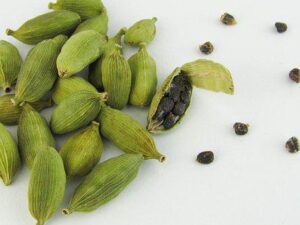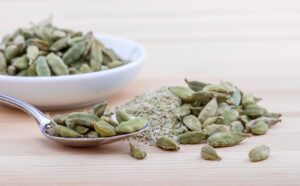Cardamom is a spice made from the seed pods of various plants in the ginger family. Cardamom pods are spindle-shaped and have a triangular cross-section. The pods contain a number of seeds, but the entire cardamom pod can be used whole or ground. The seeds are small and black, while the pods differ in colour and size by species.
There are two main types of cardamom: black cardamom and green cardamom, and there is also white cardamom which is a bleached version of green cardamom. Green cardamom is the kind found most often in Nordic and Middle Eastern cuisine, while recipes in India and Asia will often specify whether green or black cardamom is used.

Green cardamom (Elettaria cardamom) is known as true cardamom. This is the most common variety you will see sold in the spice aisle of the supermarket. It is the top choice for sweet dishes but also works well in savoury dishes. The bleached version, white cardamom, has less flavour. It is grown in tropical areas including India, Malaysia, and Costa Rica. Black cardamom (Amomum subulatum) has larger pods that are dark brown. It has a smoky element that makes it more appropriate for savoury dishes, but it is used in sweet dishes as well in southern India. It is grown in the eastern Himalayas.
Cardamom may be helpful for people with high blood pressure. May Contain Cancer-Fighting Compounds. The compounds in cardamom may help fight cancer cells. Cardamom powder can increase the activity of certain enzymes that help fight cancer. The spice may also enhance the ability of natural killer cells to attack tumours.
Cardamom is rich in compounds that may fight inflammation. Inflammation occurs when your body is exposed to foreign substances. Acute inflammation is necessary and beneficial, but long-term inflammation can lead to chronic diseases. Antioxidants, found in abundance in cardamom, protect cells from damage and stop inflammation from occurring
Cardamom has been used for thousands of years to help with digestion. It’s often mixed with other medicinal spices to relieve discomfort, nausea and vomiting. The most researched property of cardamom, as it pertains to relieving stomach issues, is its possible ability to heal ulcers.
The use of cardamom to treat bad breath and improve oral health is an ancient remedy.
In some cultures, it’s common to freshen your breath by eating entire cardamom pods after a meal. Even the chewing gum manufacturer Wrigley uses spice in one of its products. The reason why cardamom can lead to minty fresh breath may have to do with its ability to fight common mouth bacteria
Cardamom also has antibacterial effects outside of the mouth and may treat infections.
Research shows that cardamom extracts and essential oils have compounds that fight several common strains of bacteria. It may Improve Breathing and Oxygen Use. Compounds in cardamom may help increase airflow to your lungs and improve breathing. When used in aromatherapy, cardamom can provide an invigorating odour that enhances your body’s ability to use oxygen during exercise. May Lower Blood Sugar Levels. When taken in powder form, cardamom may lower blood sugar.

In addition to the aforementioned health benefits, cardamom may be good for your health in other ways as well. Green Cardamom extract may decrease elevated liver enzymes, triglyceride and cholesterol levels. They may also prevent liver enlargement and liver weight, which reduces the risk of fatty liver disease. One rat study suggests that cardamom extract may prevent anxious behaviours. This may be because low blood levels of antioxidants have been linked to the development of anxiety and other mood disorders.
Cardamom is generally safe for most people. The most common way to use cardamom is in cooking or baking. It’s very versatile and often added to Indian curries and stews, as well as gingerbread cookies, bread and other baked goods. The use of cardamom supplements, extracts and essential oils is likely to become more common in light of the promising results of research on its medicinal uses.
